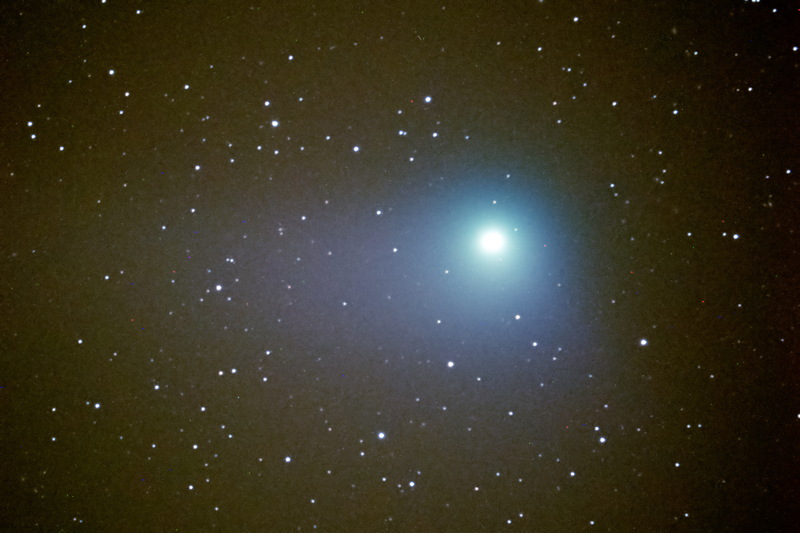
Imaging: Jupiter-Venus Conjunction,
NGC 2438, NGC2440, Comet Garradd
Posted: 13 March 2012
Clouds and wind returned on Sunday, 11 March, but they were gone the next day. I opened the observatory on Monday, 12 March 2012, at 1806 MST, 78°F, to mostly clear skies with some clouds low in the south. As I arrived at the observatory, I saw these horseback riders on top of the hill to the east:

At 1810 MST, viewed Venus, 77X. I then did another attempt to capture the "green flash" as the sun set behind distant mountains. No luck. Will keep trying, as I have seen the green flash occasionally from here.
At 1845 MST, with my naked eyes, I could just see Mercury, low in the west, by sighting along the finderscope mounting screws. It was not yet visible in the finderscope. At 1850 MST, I viewed Mercury in the 8" LX200-ACF, 77X and 206X. A nice crescent phase was seen. Mercury was now visible in the finderscope as well. At 1856 MST, viewed Jupiter and its four moons, 206X.
I did some sky photography of the conjunction of Jupiter and Venus with the D7000 DSLR using a 300mm telephoto lens. This is an f/8, 1/10sec, ISO 500, exposure. As seen in the magnified inset, even the four Galilean Moons were captured:

Beginning at 1918 MST, while waiting for twilight to end, I used Observer Pro on the iPhone to check for some previously unobserved and unimaged DSOs. I found several. At 1940 MST, I took a last look at Jupiter, 206X. I then began DSO observing at 77X. Viewed:
NGC2438 - nice but faint planetary nebula near an open star cluster
NGC2440 - very small planetary nebula, almost like a fuzzy star
NGC2683 - nice edge-on galaxy
NGC2964 - faint galaxy, with a smaller galaxy nearby
NGC3227 - faint galaxy, best observed with averted vision
M109 - faint galaxy, nice with averted vision
I added all of these to my astrophotography list.
At 2010 MST, I viewed Comet C/2009 P1 (Garradd), 77X. I would image it later this night. Currently, the nuisance light from the northeast neighbor was impacting the view.
At 2014 MST, I began setting up to image the two planetary nebula I viewed earlier. Mounted the D7000 DSLR at prime focus (on the star diagonal). Did a focus test using the star Sirius with the Bahtinov Mask. Went to NGC2438 (planetary nebula) but could not see it in the camera viewfinder. Did some framing test exposures and eventually got a good framing. This is an unguided, full-frame, 45 second, ISO 6400, exposure:

SYNCed on the position of NGC2438 and went to NGC2440, the second planetary nebula. Did a framing test exposure and then could see the nebula in the camera viewfinder. Reframed and did this unguided, cropped, 45 second, ISO 6400, exposure:

(It turned out that I had previously imaged, NGC2440. I missed seeing it on my astrophotography list. The image is on the Comets photo album.)
I then removed the camera from the telescope, SYNCed on Regulus, added the focal reducer, and slewed to Comet Garradd. It was nice in the 26mm eyepiece + focal reducer. I then slewed to Alpha Ursa Major, remounted the camera with the Off-Axis Guider, and did a focus test with the Bahtinov Mask. (The nuisance light from the neighbor was now off. Thank you.) Did some framing test exposures; the comet was visible in the camera viewfinder. I did some unguided 1 and 2 minute, ISO 6400, exposures. I then located an excellent guidestar and did a 5 minute, ISO 6400, and 5 and 10 minute, ISO 5000, guided (on the star) exposures. This is a guided, cropped, 10 minute, ISO 5000, exposure:

I ended imaging for the night at 2146 MST. (I'll image the other DSOs on the next session.) I removed the camera and focal reducer. I took a quick look at Comet Garradd, 77X. I then viewed NGC2371, planetary nebula (another one I picked from Observer Pro), 77X. It was very faint; had to use 133X to verify that what I was observing was the planetary nebula; it was. (I'll image it on the next session.)
I then viewed Mars at 77X, 133X, 206X, and 364X. All nice views with the North Polar Cap and some dark areas visible. I then began closing up for the night.
The observatory was closed at 2215 MST, 55°F.
Go to the previous report.
Return to the Cassiopeia Observatory Welcome Page.